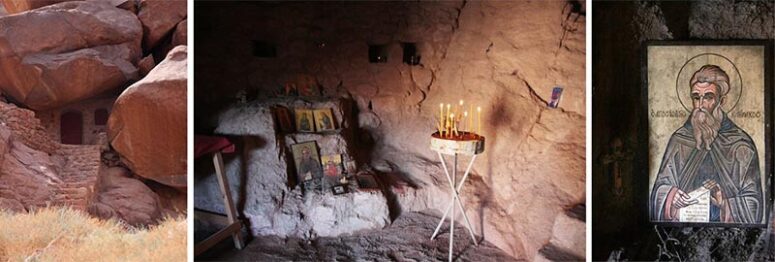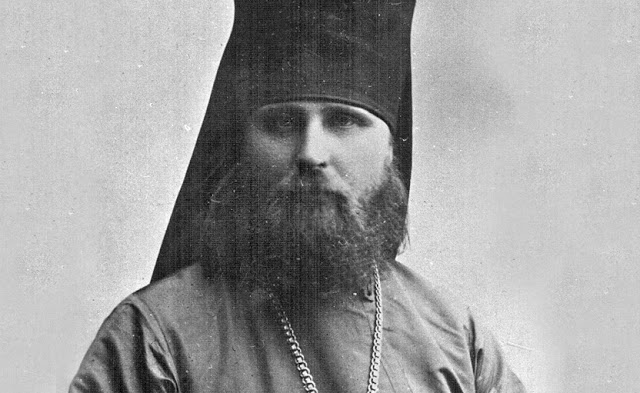One day a group of pilgrims visited the Monastery of Elder Porphyrios Kavsokalivite in Milesi. Among them was a woman from France, a history teacher at the university, a convinced atheist who professed nihilism. She did not expect much from a meeting with a man who had only completed two years of school, but at the request of her friends she decided to talk to the Elder.
Elder Porphyrios insisted that they speak alone, without an interpreter. After a long conversation, the Frenchwoman left the cell in tears.

When asked how she understood the words of the Elder, who spoke only Greek, she replied in amazement: “He speaks fluent French!”
A German doctor had a similar encounter with the Elder, as did pilgrims from Serbia, Romania and Ireland…
Later, answering the questions of his spiritual children, Elder Porphyrios explained this miracle as follows: “I speak to people in Greek and the Holy Spirit interprets my words in their minds and hearts”. The language of the Holy Spirit, once forgotten by the pride of the tower-builders of Babylon, is revealed again in the Holy Church through saintly people who please God with their righteous lives.
Meeting such a person forever changed the life of the history professor Marie Madeleine le Beller. A few years later she renounced worldly life and chose the path of solitary asceticism in the desert near the Sinai Monastery.

Baptism and Beginning of the Ascetic Life of Nun Mary Magdalene
Marie Madeleine Le Beller, a former atheist, travelled to the Holy Land and was baptised in the Jordan River in 1986. She was 40 years old. After her baptism, she decided to dedicate her life to God and to live in solitude. Before taking this important step, the future nun received the blessing of Elder Porphyrios Kavsokalivite, Archimandrite Sophrony (Sakharov) and other ascetics.
For a long time Marie prayed to St John Climacus to show her the right path. Then she sold her house in Paris and bought a piece of land from a Bedouin in the Sinai desert, near the cave of St John, a few kilometres from the monastery of St Catherine.

In her hermitage, the Frenchwoman was known as the Nun Mary Magdalene. Her ascetic exploits were not easy: for the first period of her life in Sinai, she lived without shelter, among rocks and boulders, with only a sleeping bag. Her only companions were scorpions and poisonous snakes. Many people shunned her and thought she was mentally ill.

The plot of land Nun Mary bought had only a carob tree and a well. Over time she planted an orchard of apple and olive trees and built a hermitage: several cells, a chapel on a rock and a small pond.

A Solitary Life
For a long time, Mary Magdalene’s relations with the inhabitants of the Monastery were complicated. Some monks supported her, but many believed that she should not live alone in the desert without first spending some time as a novice in the women’s convent in the oasis of Feiran.
The Nun’s faith was then strengthened by the memory of the Elders’ blessing. On his last visit to Sinai, Venerable Paisios of the Holy Mountain visited the Feiran Monastery. After talking to the Nun Mary, he gave her his blessing for a special rule of prayer and the solitary life of a hermit.

In the hermitage she founded, Mary Magdalene led a simple ascetic life, praying, tending the garden and making rosary beads. In later years she became a woodcarver and decorated the chapel with icons. On Sundays and holidays she attended services at Sinai Monastery and spent Holy and Bright Weeks in Jerusalem.

She last travelled to the Holy Land for Easter in 2009. In November 2012, she travelled to Crete for a medical check-up, where she was diagnosed with advanced bowel cancer.
Illness
Nun Mary travelled to Russia to be examined and treated for her illness. She was acquainted with the Bishop in charge of St Alexis Hospital, the Metropolitan of Moscow. There, after an examination, she was offered a course of chemotherapy and surgery at a major cancer centre in Russia. However, she did not accept the offer, preferring to die in her beloved hermitage.

Before returning, Mary visited the Sarov desert. Then she passed through the city of Bari and the church of St Nicholas the Wonderworker. In Bari she met a Russian woman called Euphrosyne and asked her to accompany her to the Sinai Peninsula. Euphrosyne took care of Mary Magdalene in her hermitage for almost a year, until the last day of the Nun’s earthly life. By the grace of God, they lived in harmony despite the language barrier (Euphrosyne spoke only Russian, which Mary barely understood).

Death and Miracle at the Funeral
After Easter 2013, Mother Mary almost stopped moving. She was no longer able to attend services in the Monastery, but she bore the cross of her painful illness with great courage and patience, without medical assistance or hospital care.
She departed to the Lord in her cell on the feast of St Spyridon of Trimiphunt, 12 December 2013, at 13:00. Before her death, Father Paulos of the Sinai Monastery celebrated the Divine Liturgy in the hermitage and gave the Nun Holy Communion.
The body of the ascetic was taken to the hospital to be pronounced dead. Permission from the French Consulate had to be obtained for the burial. It was granted on the night of 17 December and the funeral was arranged for the following day.

The body of the Eldress was to be taken from the hospital back to the Monastery, when a strange and mysterious event occurred. Suddenly a snowstorm broke out and the whole area was covered with snow. Fourteen Coptic men were sent from the Monastery to carry the Nun’s body over the rough terrain to her hermitage.
Normally, the journey from the motorway to the hermitage would have taken an hour, but in such difficult weather conditions it could have taken two hours. However, when the workers lifted the remains of the Eldress, the blizzard stopped and they travelled to the hermitage in just 45 minutes. By the time the body was brought to the hermitage, the blizzard had returned.

Although the Eldress wished to be buried in her hermitage, at the insistence of the Fathers of St Catherine’s the burial took place in the cemetery of the Monastery of Feiran. The funeral was performed by Archbishop Damian of Sinai and Hieromonks Michael and Eugene with four nuns from the Feiran Monastery. Of those close to Nun Mary Magdalene, only Euphrosyne was present, who selflessly served the elderly nun until the end.

Saint Paisios of the Holy Mountain wrote:
“A monk withdraws from the world not because he hates it, but because he loves it and wants to help it with his prayer in things that transcend human effort, relying on divine intervention. This is how God brings salvation to the world”.
In our time, when love and holiness seem to be in short supply, God reveals His ascetics to the world. Although many remain unknown to us, they pray fervently for the whole of humanity and for our existence on this earth. It is through their intercession that the world finds its foundation.
Sources used:
http://pravoslavnebrno.cz/jak-puvodne-francouzska-ateistka-zmenila-po-setkani-se-starcem-porfyrijem-zpusob-zivota-a-stala-se-mniskou/
https://www.johnsanidopoulos.com/2019/04/eldress-mary-magdalene-marie-madeleine.html?fbclid=IwAR1s5PUVbpJCf30lgcLz8DlzJSW8XA8a6DP5Vul6PxAv0NGr4vmP1alFLqo
Photos taken from https://hram-sokol.livejournal.com/1126737.html






The story of sister Mary Magdalene is truly formidable and remarkably inspiring. May her memory be eternal!!
A truly inspirational life, and we are blessed in reading it and contemplating the initial urgings by the Holy Spirit given to men and women chosen by God for the work of praying for the world .All things are possible with God, and learning about holy men and women who dedicated their lives to His prayer for the world is a gift indeed.
Thank you for this beautiful and encouraging story of a holy life.
Thank you for sharing! I love articles especially about Orthodox women saints and monastics. Your article was excellent! May Nun Mary Magdalene’s Memory Be Eternal. May she pray for us sinners!
So grateful for this special article.
It is truly incredible to hear that there exists in these times, souls who choose to take the narrowest path in faith. The fact that this holy woman who was once an atheist became Christian is a blessed wonder it its own right; but, the fact she chose to venture where few would even consider for her love of God along with her holy desire to dedicate the rest of her life to Him in extreme humility is remarkable. It was her calling to take this holy path; but, it is our Lord who chose her for her special mission to prove God’s work remains alive and in motion.
God bless her holy soul. God bless you for sharing this story with us.
Very precious and inspiring!
Thanks a lot for sharing.
May she bless us! Mf
A beautiful, full of hope and faith account of the cross roads of this nun with others….it is mystic. As Orthodox we read and experience these accounts which bless us and encourage us to keep looking at Christ and not the world…
I am not an ascetic…but believe in prayer. I am married, a retired spec ed teacher who is Orthodox now for 12 gorgeous, trying and victorious years. We attend Holy Myrrhbearers’ Antiochian Orthodox Church in Bonners Ferry, ID where Fr Gregory Horton baptized us both; It was my 4th baptism, my husband’s first. I care for my husband, injured birds and love bugs and flowers. I pray for many around the world too who God puts in my path. We now live back in Montana but still go the HMAOC. Thank you for telling this wonderful story of Nun Mary Magdalene; we share the same name. I have shared her story with many here today and pray she will pray for all of us still struggling on this earth. Amen
Thank you for your article. I hope to learn more about when she was tonsured, who tonsured her, etc? I am a little confused about the timeline of her tonsure. Was it immediately after she was baptized? Thank you!